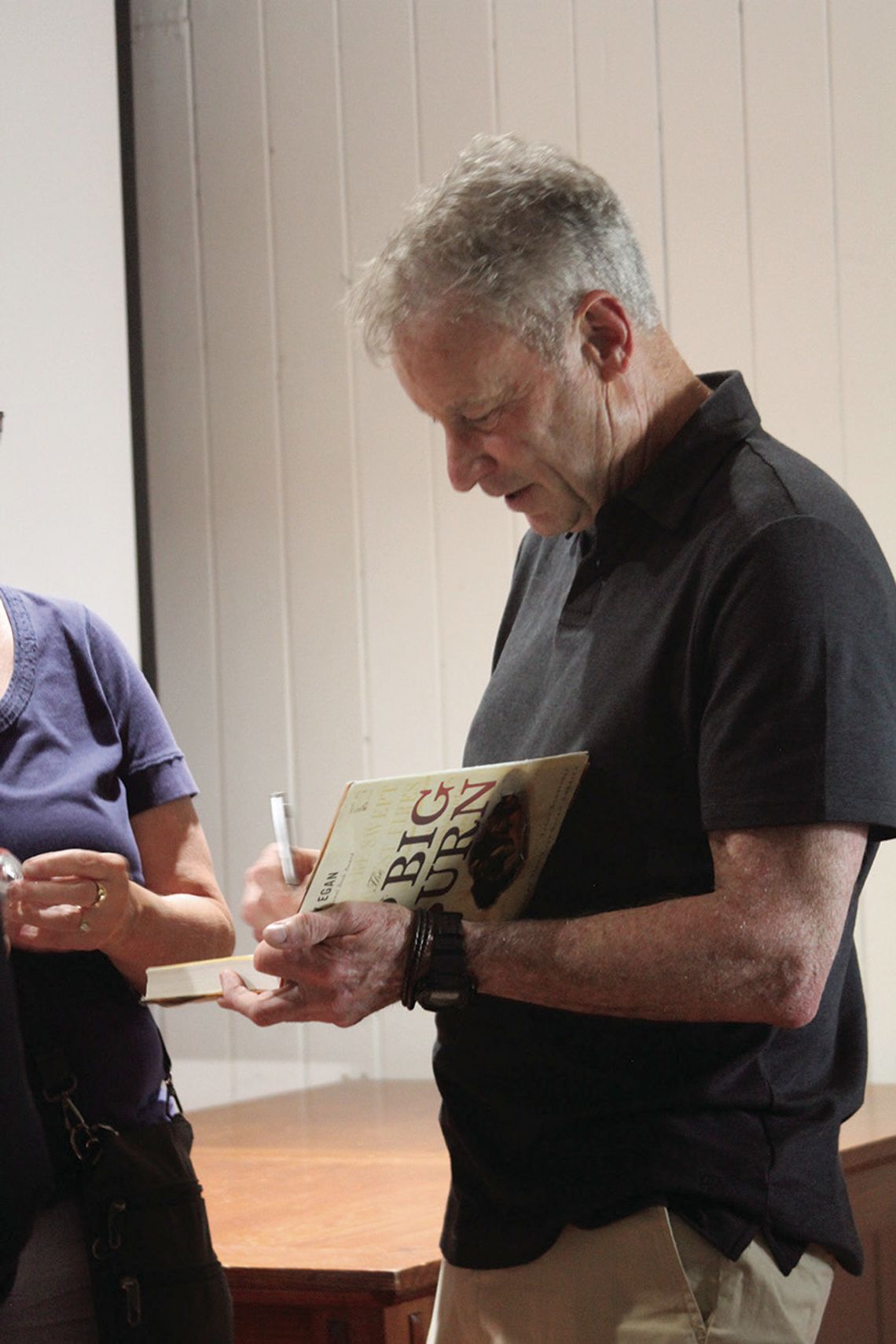Author shares stories behind massive wildfire
NEWPORT — Wildfire has burned its way into the history of the Inland Northwest, and the Pend Oreille River Valley is no exception. To touch on that past and how it helped create the public lands locals and tourists flock to for recreation, bestselling author Timothy Egan visited Newport and Metaline Falls Monday, June 16 to discuss his book “The Big Burn: Teddy Roosevelt and the Fire That Saved America.”
“Wow,” Egan said, joking with the large crowd at Create Art Center where his evening presentation was held. “I honestly thought only three or four people were going to show up. Thank you for not having anything better to do.”
In just two days in August 1910, the largest wildfire in U.S. history destroyed 3 million acres in Eastern Washington, Idaho and Montana, leveling five towns, countless trees and leaving at least 85 people dead, including three Newport area residents. However, the devastation did not end the beginning of President Teddy Roosevelt’s fledgling federal agency, the United States Forest Service.
“Nowadays public land is something we take for granted,” Egan said. “Around seven out of 10 people in the United States live around 100 miles from public land, whether it’s a national park, Forest Service land, Bureau of Land Management, Department of Natural Resources — it’s become so ingrained in our cultural subconscious that it can be easy to assume it’s always been that way.”
The U.S. Forest Service was founded in February 1905 by Roosevelt and Gifford Pinchot, despite resistance from congressional senators and wealthy lobbyists, who saw the formation of public lands as a hindrance to economic gain.
Egan said that while Pinchot’s efforts were well-intentioned, he got ahead of himself when it came to the subject of wildfire.
Three days before dry lightning sparked the fire of 1910, Pinchot rashly declared that the Forest Service had completely tamed wildfire.
“It was obviously a rash thing to say, and he would be proven very wrong,” Egan said.
In August of 1910, severe drought, abnormally high temperatures and powerful winds came together to trigger the firestorm.
“It was said that walking in the forest that summer was like walking over potato chips,” Egan said. “The ground was so dry, and the pine needles were so crunchy.”
The fire started August 20.
Powerful winds created a massive blaze with its own weather system, creating flames hundreds of feet high and creating 80-miles per hour gusts, Egan said. The Newport Miner reported that the fire burned eastward and extended as much as 10 miles wide by the time it jumped the Pend Oreille River. At that time, Pend Oreille County hadn’t been formed and was still considered part of Stevens County.
According to the Pend Oreille Heritage website, resident Fred L. Wolf described the scene: “Those who saw the onward sweep of the fire have not yet recovered from the awe inspired by the spectacle. As the fire reached the Pend Oreille River, great black clouds puffed out and leaping ahead formed the advance guard. Thick with burning embers they scattered the fire before them. Closer to the earth, all things took on a ghastly orange tinge, the clear and sparkling Pend Oreille assumed the hue of the turbid Missouri and was scarcely recognizable. It looked like the end of all things, that no living creature could come through the disaster fast approaching.”
Locals scrambled for their lives, many of them working frantically to protect their homes and property. Reports indicate that most of the houses on the east side of the river were destroyed. Killed in the fire were Mrs. Deinhardt, George W. Zeigler and George R. Campbell.
The enormous wildfire lasted approximately 48 hours, with smoke that drifted all the way to New England.
According to Egan, the fire’s timing solidified monetary and public support for the new Forest Service, but it also laid a misapplied course for fire management.
“It’s understandable that people were traumatized by the fire of 1910, but you could say that caused the pendulum to swing the other way,” Egan said. “Fire suppression policy reached its extreme in 1935 with the 10 a.m. rule — mandating that any fire spotted in a given day must be controlled by 10 a.m. the following morning.”
Indigenous people realized that wildfires were a necessary part of life, Egan said. Certain tree species, including ponderosa pine and sequoia, depend on fire to clear the ground for seed germination. Fires also help curb insect infestations of trees, bringing balance to forest ecosystems. Over the years, land management has evolved to include controlled burns.
At the end of the event during the question-and-answer period, Egan was asked if he would ever consider hiring a researcher to help him with his novels.
“Not as long as I have the ability to do it myself,” Egan said, smiling. “That’s part of the fun, being able to see historical documents like Teddy Roosevelt’s letters in person and travel to the places where these events that shaped our present happened.”
Egan is a renowned writer and longtime chronicler of American history. He is a Pulitzer Prize-winning reporter, a popular columnist and a National Book Award-winning author of 11 books, including “Breaking Blue,” the true story of Newport police officer George Conniff who interrupted a burglary of the Newport Creamery in 1935. When he confronted the two men, one of them opened fire. Officer Conniff died the next day from his wounds. The incident became the longest-running murder investigation in the nation. Egan’s book “The Worst Hard Time: The Untold Story of Those Who Survived the Great American Dust Bowl” led to the Ken Burns film “The Dust Bowl” and won the National Book Award.
“The Big Burn” is available to borrow in print at all Pend Oreille County Libraries, and as an eBook or audiobook via the library’s free apps, Libby and Hoopla.
SOPHIA MATTICE-ALDOUS IS A MURROW NEWS FELLOW WORKING DIRECTLY WITH NEWSROOMS AT THE NEWPORT MINER AND RANGE MEDIA THROUGH A PROGRAM ADMINISTERED BY WASHINGTON STATE UNIVERSITY. HER REPORTING IS AVAILABLE FOR USE VIA CREATIVE COMMONS WITH CREDIT.
.png)







